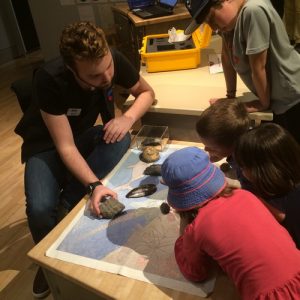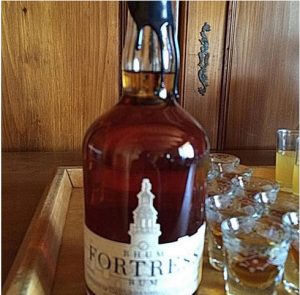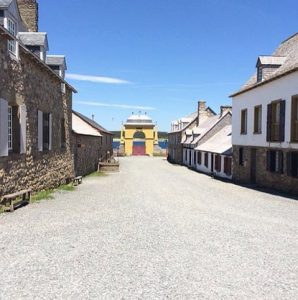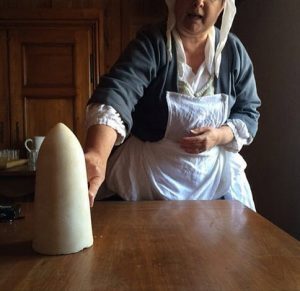Tag Archive
activity architecture art artist building Canada children city CostSaver downtown drive i-95 entertainment Europe event exhibit family festival Florida food fun historic History landmark local Museum music Nature New Zealand Ontario roadtrip sculpture Seattle show sights sightseeing tour tourist Trafalgar travel travelblogger view Washington Washington State water world
Canada: Cape Breton, Nova Scotia – Typical Meal in the 18th Century
In the eighteenth century at Fortress Louisbourg, Cape Breton, Nova Scotia, the lower class diet included locally prepared bread, spruce beer, meat or fish. Staples like butter, cheese, and rum were imported. Here I dined on pea soup and an apple tart for dessert. They ate with spoons. Gathering for a meal was not only for sustenance but also for news, companionship and games of chance.
Canada: Cape Breton, Nova Scotia – Smooth Rum
Fortress Louisbourg, Cape Breton, Nova Scotia, is producing smooth rum – a drink that would have been downed by rich and poor in the 18th century. Don’t forget to bring it home as a souvenir. Every time you feel the smooth liquor go down, you’ll remember your trip – and how lucky we are to live in this century. To buy it, just ask for Fortress Rum, what else?
Canada: Cape Breton, Nova Scotia – Perfume Court
Before you enter Fortress Louisbourg, Cape Breton, NS, you can visit a fisherman’s cottage and learn about their lives in the 18th century. Perhaps they were the lucky ones living outside the walls, for the aboriginals said you could smell the fortress before you arrived as soldiers rarely bathed and there were no toothbrushes. Aboriginals stayed way outside the fortress. Now we know why Louis XV court was called the “perfume court” as they needed to cover up the human aromas.
Canada: Cape Breton, Nova Scotia – Chief Engineer
Etienne Verrier was chief engineer for Fortress Louisbourg from 1725 to 1745 and lived here, in one of the most imposing homes. The military engineers were town planners, architects and construction engineers. They laid out the streets, planned the fortifications, designed all the colony’s public buildings and influenced military tactics in the sieges. He was wealthy enough to be able to serve cocoa to his guests. A pound of cocoa cost the same as a pair or shoes. The cocoa was served hot with spices and sugar and was used medicinally and for warmth and strength.
Canada: Cape Breton, Nova Scotia – Chocolate for the Wealthy
Chocolate was hugely expensive in the 18th century and a pound would cost the same as a pair of shoes. You had to be wealthy to be able to serve cocoa to guests. the cocoa was served hot with spices and sugar and was used medicinally and for warmth and strength. Both women and men drank it. Ladies thought it was energizing. More than two centuries later, I think we still agree about that.
Canada: Cape Breton, Nova Scotia – Dinner Hanging Around
Cape Breton, Nova Scotia:
At Fortress Louisbourg, Cape Breton, Nova Scotia, inside the wealthy chief engineer’s house, we saw dinner hanging around. See the goose and chicken In a special contraption suspended from the rafters.
Canada: Cape Breton Island, Nova Scotia – Ornate Main Gates
Looking down the length of Rue Toulouse you can see the Bourbon majesty in the ornate arch of Frederic Gate. Most of the people, news, merchandise which arrived at Fortress Louisbourg, Cape Breton, Nova Scotia, as well as orders from the king arrived through the gate. The gate’s name honors the royal minister who managed France’s colonies and navy in the 18th century.
When ships arrived, crews pushed and carried their cargo through the narrow gateway. The sailors who landed here spoke French, English, Portuguese, Basque, Breton, German, and the Mi’kmaw of the native people. The quay was a gathering place for townspeople so they would have seen public announcements, auctions and even the punishment of criminals.
Canada: Cape Breton, Nova Scotia – Sugar Cane
The Dutch brought sugar cane to the West Indies. During the Colonial period, refined white sugar was shipped in the shape of cones, typically the product of slave labor. Once in the mold, sugar water or other solution was poured over the sugar to remove the excess molasses. The sugar loaves were then removed from the molds and dried. They were wrapped in blue paper (from Insifo) for shipping.
For transport it was shaped in molds and then wrapped in paper made from old clothes linen pulp add indigo to paper color
Salt cod was the “money” used to trade for it.
Canadian Museum of Nature is Museum of Fun
If you are heading out to Ottawa to enjoy our nation’s capitol, leave some time to explore the Canadian Museum of Nature. It’s the perfect place for all ages of the family to enjoy themselves. The brainy kids (or adults) can soak up extensive details about nature while the playful gang can pull levers or turn knobs in a deep sea sub,  learn on many touch screens, or even dance around in front of the endothermy camera checking out their colorful “hotspots”.
learn on many touch screens, or even dance around in front of the endothermy camera checking out their colorful “hotspots”.
Everyone is awed by the the 19.8-metre blue whale skeleton in the Water Gallery but keeping going further in. All the way in the back are many interactive games for young and old alike: make believe areas for the wee ones, a board game along a wall, animal jigsaw puzzles on touch screens, word games, etc.
Gawk at the dinosaur fossils or walk amongst the fleshed-out dinosaur creatures for photo ops with kids. In the Vale Earth Gallery swoon over the 1200 gorgeous minerals, rocks and meteorites. Our 5 1/2-year-old couldn’t get enough of the joystick which controls a huge earth or the button to start the volcano.
Sure there’s a full size mammal gallery but the 11, 8 and 5 1/2 year-olds all stayed longer in the small Nature Live space where they oogled the cases of walking stick bugs in different camouflage colors and thicknesses. How many of you have come face to face with a tarantula? Then they listened intently as a docent showed fossils which were indigenous to Ottawa.
If you have time there are two 3D movies, “Prehistoric Planet 3D and Micro-Monsters 3D” (both too scary for the 5 1/2 -year old) but our gang liked the interactive museum more.
The famous Bird Gallery, with one of the most extensive collections of Canadian birds in the world re-opened June 1. A special exhibit on now is Ultimate Dinosaurs June 11-September 5 and then upcoming is Reptiles: The Beautiful and the Deadly, October 6-April 2 .
A brand new Arctic Gallery will be unveiled on June 23 which is set to explain how the arctic is changing, including plants, animals and people of the area plus scientific research. Outside, three new ecozones will be shown off on June 17 including a woolly mammoths and an “iceberg”.
I’d like to give a thumbs up to the friendly security guards who answered questions informatively and helped to point out nearby bathrooms and water fountains.
Canadian Museum of Nature, a Beaux Arts building, was our first national museum, completed in 1912. Trivia buffs should note that this building served as home to Canada’s House of Commons and Senate following the fire that destroyed the Centre Block of Parliament in 1916.
Location: 240 McLeod St., Ottawa
Phone: 613-364-4021
www.nature.ca
Germany: Munich – Jewish Premier of Germany
 Kurt Eisner, a Socialist and a Jew became the first Republican Premier of Bavaria. In November 1918, at the end of WWI, Eisner, a socialist journalist and statesman, organized the Socialist Revolution which overthrew the Wittelsbach monarchy in Bavaria. He declared Bavaria to be a free state and republic on November 8, 1918.
Kurt Eisner, a Socialist and a Jew became the first Republican Premier of Bavaria. In November 1918, at the end of WWI, Eisner, a socialist journalist and statesman, organized the Socialist Revolution which overthrew the Wittelsbach monarchy in Bavaria. He declared Bavaria to be a free state and republic on November 8, 1918.
His leadership didn’t last long as he was assassinated in Munich when German nationalist Anton Graf von Arco auf Valley shot him in the back on February 21, 1919. After his death the in-fighting amongst left wing parties led to the seeds of the National Socialist Party and the rise of Hitler.
In 1989 a memorial was placed on the sidewalk on the ground at the site of his assassination.

Members of the Wittelsbach family are still alive, still own property in the city and are honored by the people of Munich and are invited to events.








